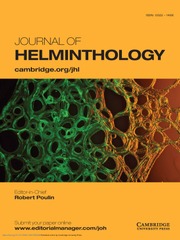Article contents
On the Transverse Fission of Cysticercus pisiformis in experimentally infested Rabbits, and the Phylogenetic Significance of Asexual Phenomena in Cysticerci*
Published online by Cambridge University Press: 18 November 2009
Extract
Transverse fission of Cysticercus pisiformis begins in the liver and is usually completed there. It is brought about by one or two annular constrictions which. ultimately result in the complete fission of the original bladder-worm into two or three parts. The posterior segments thus formed are normally acephalic.
Histologically, fission involves an initial hypertrophy of the cuticle and subcuticula at the zone of constriction, followed by their degeneration and loss, and by the increase and consolidation into a slender cord of the muscle and parenchyma fibres. With the rupture of the cord and the sealing up of the broken ends, fission is complete.
The majority of the bladder-worms do not undergo fission, but the process is apparently spontaneous and quite normal for the species. Its cause is unknown, but it is thought to have a phylogenetic significance.
- Type
- Research Papers
- Information
- Copyright
- Copyright © Cambridge University Press 1948
References
- 9
- Cited by


